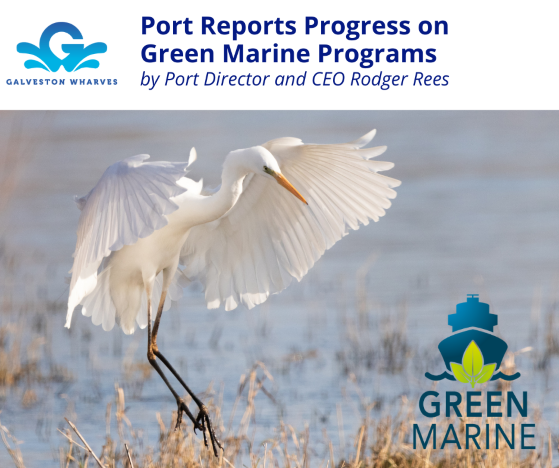Archives
Freight News, Sea
Port of Galveston reports on Green Marine Program
[ April 12, 2022 // Gary G Burrows ]Since becoming certified in the Green Marine program in June 2021, the Galveston Wharves and its partners are making progress in realizing long-term changes to protect the environment. Cleaner energy sources, waste reduction and sustainable construction are just a few examples.
Guided by Green Marine, a voluntary environmental program for North America’s maritime industry, the port staff is researching, planning and implementing several new programs. Joining Green Marine helps the port identify and implement best practices, manage environmental initiatives, measure progress, and strive for continuous improvement.
In March the port submitted its first annual report detailing activities in nine areas. Objectives range from air quality and waste management to community and environmental leadership. The self-evaluation is required to maintain Green Marine certification.
Air Quality
The port and its partners are taking steps to improve air quality. Building an interior roadway to accommodate cruise and cargo traffic is expected to relieve traffic congestion and idling time on Harborside Drive. Moving some cargo operations from Pier 10 to the West Port Cargo Complex shortens the distance tractor trailer trucks travel to and from the interstate highway.
There is growing interest in powering docked ships with shore-side electricity instead of onboard diesel auxiliary engines. Texas A&M University is conducting a study of shore power for cargo ships, and a major energy company has approached the port about a public-private partnership. Royal Caribbean International (RCI) is outfitting its new cruise terminal for shore power for when it becomes available for the Oasis-class Allure of the Seas. Carnival’s Jubilee, scheduled to homeport in Galveston in 2023, will run on liquified natural gas (LNG).
The port and its partners are pursuing opportunities to offer LNG, a safe, clean-burning marine fuel, to improve air quality and meet global maritime industry goals.
This year we plan to conduct an inventory of greenhouse gas emissions as a benchmark from which to measure progress. Within the next five years, we also aim to complete a detailed inventory of port and rail terminal operator vehicles and locomotives.
The goal is to transition to lower-emission equipment, provide electric vehicle charging stations for cruise parking customers, begin using electric shuttles and implement other emission-reduction measures. Partnerships and grants, such as the state’s Government Alternative Fuel Fleet and Houston/Galveston Area Council’s Clean Vehicles grant programs, will help the port advance its environmental initiatives.
Environmental Leadership
Making significant environmental improvements is a team effort. We are working with our port partners, such as stevedoring companies, to share environmental programs and encourage their participation in Green Marine.
The cruise industry is already a leader in environmental initiatives to reduce waste and transition to clean-burning fuels. For example, RCI has designed its new Galveston cruise terminal to meet LEED (Leadership in Energy and Environmental) certification standards. To qualify, the building must meet a global set of health, efficiency and sustainability standards.
Reducing & Recycling Waste
The port has already implemented several waste reduction initiatives, including recycling programs and sustainable paper products. As one success story, port staff worked with tenants to identify resources to recycle discarded wheels and tires resulting from roll-on/roll-off cargo operations.
In less than a year, the port and its partners have made great progress. The best is yet to come.

Tags: Port of Galveston











